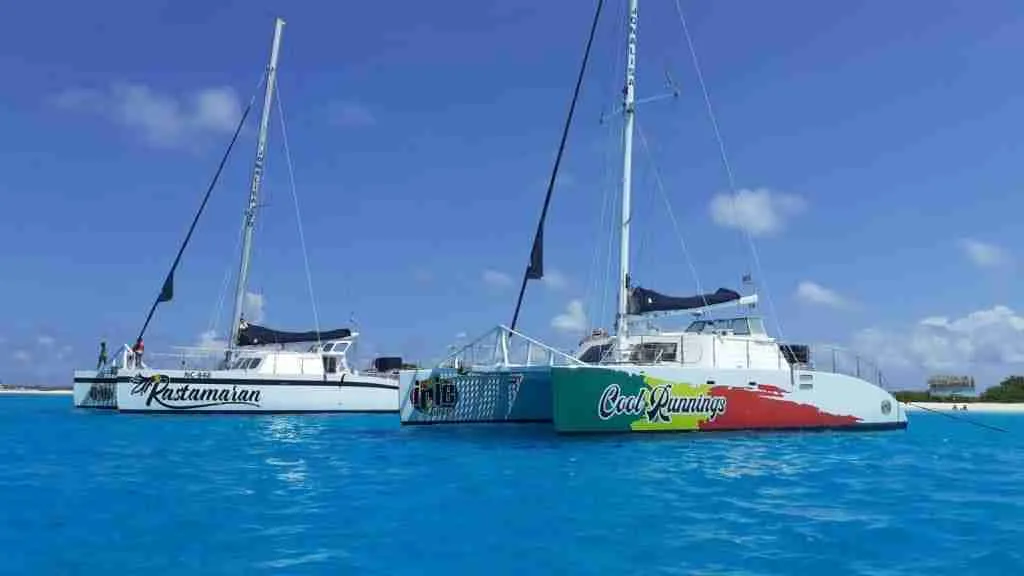To Klein Curacao on a catamaran
There are a total of two different trips on Curacao that offer the opportunity to visit Klein Curacao with a Catamaran. If you want to know exactly what to expect from these trips, please refer to the specific trip pages on our website. If you are interested in the trip with the somewhat smaller, fast catamaran visit IRIE Times catamaran trip. If you would prefer to learn more about the trip on the island’s largest and most comfortable catamaran take a look at Blue Finn catamaran trip. In this article, we will take a closer look at exactly what a catamaran is and how it differs from regular single hull boats.
Introduction
Catamarans, with their distinctive double hulls and impressive stability, are a striking sight on the world’s seas and lakes. In this article, we take a closer look at exactly what a catamaran is, its history, features, types, benefits, applications and even a look at the possible future of these unique craft.
History of the Catamaran
The term “catamaran” has its origin in the Tamil word “kattumaram,” meaning “bound wood.” The history of catamarans is fascinating, with roots dating back to ancient civilizations. Early development and important historical moments contributed to the modern catamaran as we know it today.
Oldest Traces of the Catamaran
Although the modern catamaran looks very different from its ancestors, there is evidence that catamaran-like craft were used thousands of years ago. One of the oldest traces of catamarans comes from the Indian region of Tamil Nadu, where petroglyphs have been discovered dating to about 500 BC. These drawings show two-berth vessels that were used for both trade and fishing. These early catamarans had wooden hulls and were propelled by sails.
The Polynesian Catamarans
Another early appearance of catamarans was in the Polynesian Islands. Known for their impressive navigational skills, the Polynesians used catamarans with bamboo and reed hulls, which were light and fast. These vessels were often used for ocean voyages and were at the forefront of the development of modern sailing catamarans.
The Modern Reinvention
The modern reinvention of the catamaran began in the 1940s and 1950s, when adventurous sailors began experimenting with new designs. Pioneers such as James Wharram and Arthur Piver began building sailing catamarans inspired by Polynesian designs, but with modern materials and techniques.
An important milestone was the introduction of the Hobie Cat in 1968 by Hobart “Hobie” Alter. The Hobie Cat, a small sailing catamaran, quickly became popular with water sports enthusiasts around the world because of its accessibility and speed. This contributed to the growing popularity of the modern catamaran.
Catamarans in Racing Sailing
Catamarans have also made their mark in competitive sailing. In the 1970s and 1980s, catamarans, especially the Tornado class, began to participate in Olympic sailing competitions. These boats, with their double hulls and large sails, provided breathtaking speeds and exciting races.
Another groundbreaking development was the introduction of America’s Cup catamaran racing in 2013. These races, with high-tech, foiling catamarans, took the catamaran world to a new level of speed and technological innovation.
Modern Catamarans in Recreational Sailing
Today, catamarans are not only popular in competitive sailing, but also in recreational sailing. They are often chosen for their stability, spacious interiors and impressive speed potential. Catamarans range in size from small sailboats to luxury yachts that can accommodate multiple guests.Top form
Definition and Characteristics
A catamaran is a vessel with two parallel hulls connected by a frame. This particular hull shape offers unique advantages such as stability and efficiency. We explore the essential characteristics of catamarans and explain what sets them apart from other craft.
Types of Catamarans
Catamarans come in different types, each designed for specific purposes. For example, sailing catamarans offer unparalleled speed, while motor catamarans are known for their comfort. Racing catamarans take speed and technology to the next level. The catamarans used to go to Klein Curacao have both a sail and an engine. The reason is that on the way out to Klein Curacao we always sail against the current. To make it possible to still reach Klein Curacao as smoothly as possible, we always use the engine on the way out. On the return, the sails do get hoisted. Depending on the strength of the wind, this may or may not be in combination with the use of the engine.
Benefits of Catamarans
Catamarans, with their distinctive double hull structure, are rapidly gaining popularity as an attractive option for sailors and water sports enthusiasts around the world. These unique vessels offer numerous advantages over traditional monohull sailboats and motor yachts. Let’s look at some of the main advantages of a catamaran.
Stability on the Water
One of the most striking advantages of a catamaran is its impressive stability on the water. Thanks to the two hulls located below the surface of the water and with significant spacing between them, a catamaran offers much less chance of leaning or tilting than monohull sailboats. This makes catamarans particularly suitable for people who suffer from seasickness, as they are less sensitive to the movements of the waves.
Space and Comfort
A catamaran offers significantly more living space than a traditional sailboat of similar dimensions. The wide hulls of a catamaran allow for spacious and comfortable cabins, lounges and decks. This means more space for lounging, dining and relaxing on board. Moreover, catamarans often have an open and airy layout, allowing you to enjoy breathtaking sea views from almost every corner of the ship.
Speed and Efficiency
Catamarans are known for their impressive speed and efficiency on the water. Dual hulls significantly reduce water resistance compared to monohull sailboats, allowing catamarans to easily reach high speeds even in moderate wind conditions. This speed and efficiency make catamarans suitable not only for pleasure cruising, but also for longer trips and even competitive sailing.
Shallow Draught
Another advantage of catamarans is their shallow draft. Most catamarans have a relatively low keel located under each hull. This makes it possible to navigate shallow waters, such as lagoons, coastal waters and bays, where monohull sailboats with deeper keel designs would have difficulty navigating. This allows catamarans to access remote and picturesque locations inaccessible to other boats.
Safety and Self-aligning
Catamarans are known for their safety on the water. Thanks to double hulls and inherently stable construction, catamarans are less likely to capsize than monohull sailboats. In addition, many modern catamarans are equipped with systems that help them automatically right themselves again in case of extreme conditions, which is reassuring for sailors worried about potential emergencies at sea.
Applications of Catamarans
From recreational use for sailors to commercial shipping and maritime research, catamarans have diverse applications. Find out how these versatile vessels play a role in various industries.
For a trip to Klein Curacao on a catamaran, you have come to the right place. For more information about Klein Curacao please visit our Klein Curacao info page and if you want more information about the trips, please visit Klein Curacao trips.





